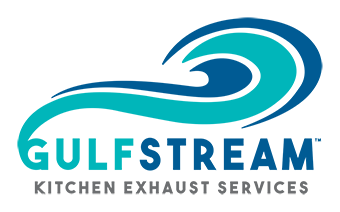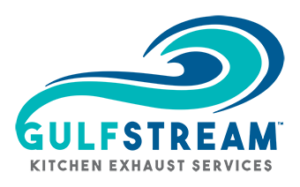Our Exhaust Hood Cleaning Process
At Gulfstream, we are proud to offer restaurants premium kitchen hood and exhaust cleaning services.
Our team follows a rigid cleaning process to ensure that your commercial kitchen hood is thoroughly cleaned and cleared of hazardous trapped grease.
1. Protect Equipment
Our team will begin by covering kitchen equipment and surfaces that are within the splash-range of your kitchen exhaust. This protects your kitchen equipment from damage and allows our kitchen hood cleaners to do their job without the risk of causing harm to other items in your commercial kitchen.
2. Clean Roof Fan Unit
Reducing the risk of restaurant fires doesn’t only involve cleaning your commercial kitchen hood. It’s equally important to make sure that all of the connecting ductwork is clean to enable your kitchen hood to run optimally and reduce the risk of fires.
Gulfstream’s team of restaurant hood cleaners will begin by cleaning the ducts and exhaust system on the roof before moving on to cleaning the kitchen hood.
3. Heated Pressure Wash
The next step in our commercial kitchen cleaning service is to eliminate residual grease buildup. Our team does this by applying a heavy corrosive to the kitchen hood and then washing it with a heated pressure washer.
Our heated pressure wash is effective at removing residual grease and giving a renewed sheen to your kitchen hood.
4. Stainless Shining
After the heated pressure wash, our hood cleaning service will use a spray bottle, sponges, and rags to shine your restaurant kitchen hood.
While this is an aesthetic step in our process, it’s still worthwhile as it gives your commercial kitchen a professional look and clean feel.
5. Site Cleanup & Mop Up
Our hood cleaning service is committed to never leaving a job with loose ends untied.
After your kitchen hood has been cleaned and shined, our team will then mop the kitchen floors and remove any garbage or cleaning debris from your commercial kitchen. Our team takes pride in going above and beyond what is expected of a restaurant hood cleaning service.
6. Post-Service Report & Dashboard
When all the work is done, our cleaners will leave your commercial kitchen with an NFPA 96 sticker to let restaurant inspectors know that your restaurant hood has been professionally cleaned.
We can also deliver date and time-stamped photos of our work on your restaurant to let insurance companies know that you are complying with restaurant regulations by having your kitchen hood professionally cleaned by a service.
FAQ’s
How long does a hood system cleaning take?
The standard clean time for a hood system is 3-5 hours. This can vary based on the size of each system, number of systems, location and logistics required to properly service.
How do I know that the entire system was serviced?
Our technicians take pictures of all areas that have been cleaned. Those pictures are then compiled and emailed to you after the service is complete along with any notes about potential deficiencies found during the service.
How often does a hood system need to be cleaned?
Most restaurants and commercial kitchens are serviced on a quarterly basis. Any system that utilizes solid fuel for cooking will need to be serviced monthly. Kitchens that do not build up much grease such as schools, churches, seasonal locations can be serviced once a year.
Do I have to be on site for the entire cleaning?
No, we have a safe and efficient key system in our shop that is highly monitored if you would like to make us a key, but you can also let our technician know how to let himself out if you prefer that method.
Are filters included in the price?
The cleaning includes the filters. Its a good practice for the kitchen staff to clean them monthly.
What type of chemical do you use?
We use a diluted version of sodium hydroxide.
How much does it cost?
There are a number of factors that go into determining the cost of a hood cleaning but we can usually give a quote over email, often times the same day.
What’s the quickest way to get a quote?
If we can get a few photos of the hood(s) emailed to us along with the name and address of the location we can start the quote. Other information we need is how many hoods (and fans) there are, how many stories is the building, and the location of the fan(s). Depending on the size and complexity of the job, on occasion, we will need to visit the location for a walkthrough but most of the time we can give you a quote over the phone and email by just getting this information, which can save a lot of time.


